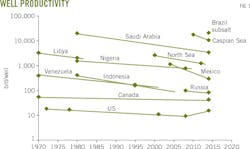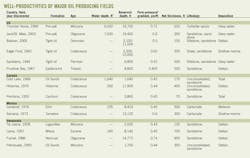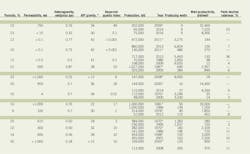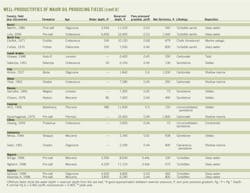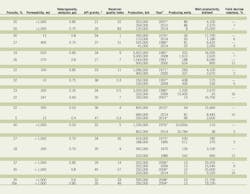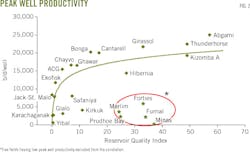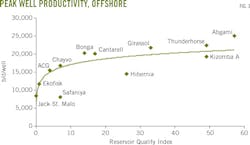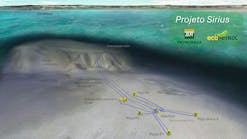New reservoir-quality index forecasts field well-productivity worldwide
Rafael Sandrea
IPC Petroleum Consultants Inc.
Tulsa
Donald A. Goddard
Liverpool Petroleum LLC
Baton Rouge, La.
Differences exist between two approaches to measuring field decline that could significantly affect appraisals. Field well-productivity performance is a more accurate measure than the industry practice of calculating decline rate based only on production.
Operators monitor field well-productivity. The index outlined by this article offers a method for executives to determine reservoir quality and make decisions about a field's economic feasibility.
The index assesses both reservoir quality and reserves quantities.
This index analyzes field well-productivity across giant oil fields such as Ghawar in Saudi Arabia and Safaniya offshore Saudi Arabia, and Karachaganak gas-condensate field in Kazakhstan. The analysis encompasses 18 oil-producing countries.
Field well-productivity is the ratio of a field's production to the number of producing wells. The study sought to determine possible patterns between peak well-productivity and established static geologic and reservoir parameters.
The index provides a compendium of core geologic parameters, well-productivities rates, and decline rates for some of the world's most productive oil fields. High well-productivity per field offsets mounting development costs associated with exploration efforts worldwide.
Field well-productivity establishes average well reserves, future drilling requirements to maintain field production levels, and future field performance. It accounts for reservoir decline, setting it apart from well-productivity of individual wells. Field well-productivity also has a characteristic exponential decline that enables the use of simple analytic tools for calculating the reserves and production rates required in field appraisals.
Operators use field well-productivity for a more sensitive measure than production rate to establish accurate peak production for both conventional and tight oil plays (OGJ, Nov. 3, 2014, p. 66).
Some fields have maintained high production rates for unusually long periods-mostly by in-fill drilling-even after peak production. China's Daqing field sustained production above 1 million b/d for over 35 years. The use of field well-productivity to measure peak production helps explain production rates.
Methodology
Fig. 1 shows well-productivity profiles from peak year to the present for several major producing countries. Big differences exist in regional well-productivity.
Although this chart is akin to production profiles, well-productivity that couples production with the number of producing wells offers a distinct advantage in that its profiles are a straight line in log-linear space, providing a relatively quick look at decline behavior.
Declines vary by country from moderate to high. The straight-line characteristic is interrupted only by major technological advances such as the recent tight-oil successes in the US, reflected by a noticeable jump in the trend line starting in 2008 when crude oil production rose 1.1 million b/d/year through December 2015.
Neither of the two additional points shown on this trend line-1978 for Alaska's production start and 2001 for the start of the Gulf of Mexico deepwater production-affected the straight-line trend.
Several geologic and reservoir parameters influence well-productivity in oil fields. Geologic factors include formation, age, depth, depositional style, lithology, net pay, and heterogeneity of the primary producing interval of each field. Reservoir factors are porosity, permeability, pore-pressure gradient, and crude gravity.
Statistics were obtained from information published by the American Association of Petroleum Geologists, the Society of Petroleum Engineers, and Oil & Gas Journal, dating back to the 1950s.
Data on field production and production wells came from the Worldwide Production Survey (OGJ, Dec. 6, 2014). Most was verified from more than one source.
The accompanying table summarizes the static parameters plus a couple of key dynamic attributes-well productivity and field decline rates-of the 34 oil fields in the study. The addition of a second well-productivity value helped determine decline rates for fields having sufficient production history. The table includes the calculated values of each field's reservoir quality index (RQI).
The table is the study's center piece. It provides perspective on the type and quality of petroleum systems that support high-quality reservoir performance in the world's best oil fields.
Parameters
Thirteen of 29 fields analyzed are onshore and have peak field well-productivity values of less than 8,000 b/d/well. The exception is Ghawar. Its field well-productivity peaked at 16,500 b/d/well in 1981.
Agbami field offshore Nigeria highest well-productivity, 25,000 b/d/well, of the 16 offshore fields in the index. The average well-productivity for onshore fields is 2,260 b/d/well (excluding Ghawar) compared with 14,470 b/d/well for offshore.
The authors observed four types of reservoirs with regard to depositional environments:
• Deepwater turbidite sandstone (Brazil, West Africa, Gulf of Mexico, Permian basin, North Sea Forties).
• Deltaic sandstone (Venezuela, Russia).
• Shallow marine carbonate-limestone (Middle East, Mexico, Caspian).
• Unconsolidated deltaic and continental sands (China, Canada, Caspian).
Environments differing from these four include the North Sea's Ekofisk Pelagic chalk reservoir, and Libya's Gialo field, a shallow marine calcareous sandstone reservoir.
Differences in depositional environments are the primary forces responsible for differences in reservoir parameters such as lithology, porosity, permeability, reservoir architecture (thickness, areal extent), and heterogeneities that refer to vertical and lateral changes over short distances.
These parameters control reservoir quality to varying degrees as reflected in the various well productivities (Fig. 1).
The late wildcatter Michel T. Halbouty coined the term the "Habitat of Oil." He listed these factors as influencing a basin's productivity capabilities:
• Source rocks with abundant marine or terrestrial organic matter (kerogen), much needed for hydrocarbon generation.
• Migration pathways, typically fault zones.
• Traps and associated reservoirs.
• Seals or impermeable zones such as shale bordering the reservoirs.
• Timing of hydrocarbon expulsion from source rocks.
Deepwater turbidite sandstone reservoirs occur in nine offshore fields in this study. Turbidite sandstone consists primarily of clastic sediments deposited in marine continental slope channels and in deep marine basins forming basinal lobes. They feature thinly laminated, fine-grained sandstone, and shale interbeds (e.g. Bouma Sequence).
Turbidite sandstone tends to have complex architecture that governs thickness and lateral extent. Typical turbidite channels and lobes provide good porosity and permeability. The presence of abundant shale laminae hampers vertical permeability.
These reservoirs contain large reserves of mostly light oil and produce at high rates because they are associated with rich marine source rocks, consisting of thick stacked sandstone-shale intervals of large areal extent.
Thirteen fields in this study, including Ghawar, originated in a deltaic-tidal environment. Deltaic sandstone reservoirs consist of several facies capable of producing hydrocarbons at economic rates. These facies include distributary channels, overbank bay fill, crevasse splay, and distributary mouth-bar deposits.
Facies having the best reservoir quality are distributary channels and mouth bars. They tend to have high porosity, averaging 30%, and high permeability, averaging 500 md.
Such reservoirs tend to be highly heterogeneous, with lithology, porosity, and permeability sometimes changing drastically over short distances. This heterogeneity can combine with meandering architecture to create vertical wells that are good producers, mediocre producers, and dry holes all within a short distance.
Typical known limestone reservoirs, such as those in Mexico (Samaria), the Middle East (Kirkuk), and the Caspian region (Karachaganak), consist of very thick beds of large areal extent with many large cavities, including vugs and fractures.
Shallow marine carbonate-limestone reservoirs are abundant worldwide. Such reservoirs are termed tight because most have low porosities, averaging 10%, and permeability of less than 1 md.
They consist of shallow water reefal calcium carbonate components that grow to form thick, dense, massive limestone beds. Fractures contribute to permeability along with vugs and other cavities, the size of which control porosity. Vugs and fractures are partly responsible for large volumes of original oil-in-place (OOIP).
These naturally fractured reservoirs typically consist of fracture-controlled, low permeability dense rock. They require fracture stimulation to increase permeability and boost flow rates. This study combined unconsolidated deltaic and continental sand reservoirs containing some of the largest reserves worldwide.
Deltaic and continental depositional environments differ in many ways, primarily the source and components of their sediments. They are similar, however, in that their clastic components are uncemented, loose sand particles, typically with porosities averaging 35% and extremely high permeability.
Examples are Venezuela's Petrozuata, China's Daqing, Canada's Hibernia, and the Caspian's Azeri-Chirag-Gunashli fields. Petrozuata consists of thick (350 ft) fine-grained clean quartz sand at depths of 800-2,000 ft. These shallow reservoirs could be invaded by nearby freshwater, causing lighter oil migrated from deeper regions to be biodegraded into ultra-heavy oil of 8-10° gravity.
Reservoir quality index
A very limited sample size makes it difficult to correlate peak well-productivity with reservoir characteristics.
The authors grouped five measurements to create RQI, defined as the product of permeability (k, Darcy), net pay (h, ft), porosity (Ø, fraction), heterogeneity (N/G or net-to-gross sand ratio), and pore-pressure gradient (Pg, psi/ft of depth): RQI = k*h*Ø* N/G*Pg where the value of k*h has been shown to be a key factor in the flow potential of a well (OGJ, Dec. 17, 2001, p. 37).
A high RQI represents excellent reservoir characteristics that are apt to correspond to high well-productivity.
Reservoir engineers use RQI to forecast performance where h*Ø is a vital term in volumetric reserve calculations. Net/gross pay is an established parameter that defines reservoir heterogeneity, often critical to determining field size. Heterogeneity mitigates permeability and also influences volumetric reserves, the master determinant of production potential.
Pg reflects reservoir energy. Values greater than 0.465 psi/ft are overpressured. These reservoirs characteristically generate both high initial production/well and high field well-productivity.
Thunder Horse field is an example of an overpressured reservoir, with a Pg of 0.72 psi/ft and a very high well-productivity of 22,400 b/d/well. The highest RQI value for this set of fields is 83, Brazil's pre-salt Lula field.
Fig. 2 is a cross-plot of peak well-productivity and RQI. Although there is a high level of scatter, the plot exhibits a definitive log-linear relationship (r2 = 0.60), making the assumed indexing concept of reservoir quality appropriate.
The authors analyzed sensitivity of the five parameters pooled into the RQI definition by removing different parameters from the original set. For instance, runs were conducted with the index limited to three parameters: k*h*Ø, or just two, k*h, and so on. Results were definitive in that the complete set of five parameters generated by far the best correlation coefficient.
Fig. 2 also shows a cluster of five rogue fields grouped apart. The fields are Prudhoe Bay, Forties, Marlim, Furrial, and Minas. All have RQIs of 22-35. They also, and inexplicably, have relatively low peak well-productivities and were therefore excluded from the correlation.
Deepwater fields showed both very high RQIs and very high well-productivities (Fig. 3). Figs. 2-3 combined document a distinctive trend that supports the proposed RQI definition.
Ghawar has with the largest reserves (110 billion bbl) discovered in more than 100 years. Its RQI of 9 provides a guideline for the best fields. Other fields exist with higher RQI values and top reservoir quality but with reserves of less than 8 billion bbl.
The table includes a column with field-decline rates. Values range from 2%/year (Kirkuk) to 23%/year (Thunder Horse). High-decline rates are typical of overpressured reservoirs. Ghawar's field decline rate is 7%/year, well within the overall average.
Bibliography
Nair, P., "Analysis of Factors Influencing Reservoir Recovery", MSc Petroleum Engineering Project Report, Herriot-Watt University, Aug. 21, 2013.
Simmons, M., "Twilight in the Desert: The Coming Saudi Oil Shock and the World Economy," John Wiley & Sons, June 10, 2005.
Sorkhabi, R., "The King of Giant Fields", GEO ExPro, Vol. 7, No. 4, July 2010.
Weimer, P., and Pettingill, H., "Global Overview of Deepwater Exploration and Production," American Association of Petroleum Geologists and US Department of the Interior, Oct. 29, 2007.
The authors
Rafael Sandrea ([email protected]) is president of IPC Petroleum Consultants Inc., Tulsa. He administers webinars and classes online and speaks worldwide on reserves, IOR-EOR, shale oil and gas assessment, and global oil and gas supply. He holds a PhD (1966) in petroleum engineering from Penn State University.
Donald A. Goddard ([email protected]) is a geology consultant on US and internation-al projects working with Liverpool Petroleum LLC. Goddard studied the characterization of clastic and carbonate reservoirs while he was a petroleum researcher at Louisiana State University. He also analyzed basins along the Gulf Coast. At LSU's Center for Energy Studies, he was coordinator of the Central Gulf Region, Petroleum Technology Transfer Council. He received MS and PhD (1978) degrees in marine geology and geophysics from the University of London.
